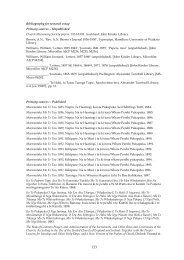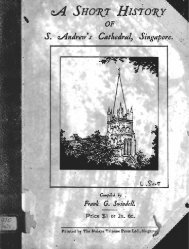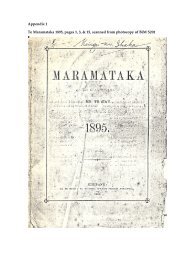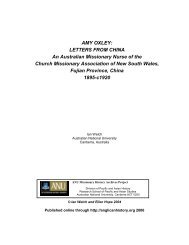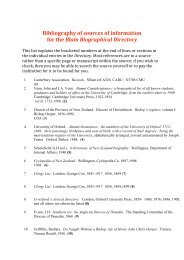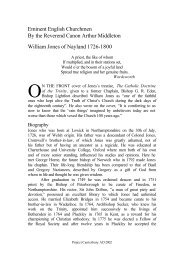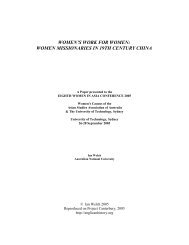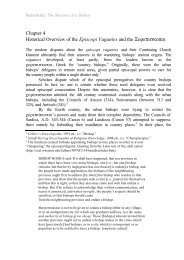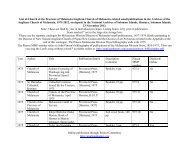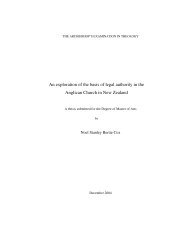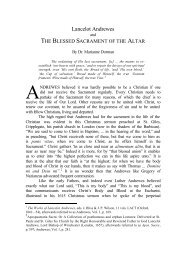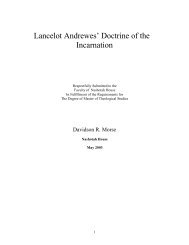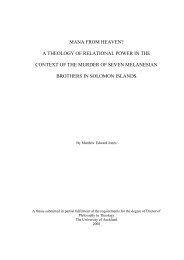The Sources and Structures of Authority in the Church, by J. - Project ...
The Sources and Structures of Authority in the Church, by J. - Project ...
The Sources and Structures of Authority in the Church, by J. - Project ...
Create successful ePaper yourself
Turn your PDF publications into a flip-book with our unique Google optimized e-Paper software.
<strong>The</strong> <strong>Sources</strong> <strong>and</strong> <strong>Structures</strong> <strong>of</strong> <strong>Authority</strong> <strong>in</strong> <strong>the</strong> <strong>Church</strong>, <strong>by</strong> J. Robert Wrightdiv<strong>in</strong>e Richard Hooker (<strong>the</strong> evidence for it <strong>in</strong> St. Thomas Aqu<strong>in</strong>as is everybit as clear <strong>and</strong> conv<strong>in</strong>c<strong>in</strong>g), it does have <strong>the</strong> advantage <strong>of</strong> attempt<strong>in</strong>g tocomb<strong>in</strong>e, <strong>in</strong> a way, all three <strong>of</strong> <strong>the</strong> approaches to <strong>the</strong> problem cited <strong>in</strong> <strong>the</strong>first paragraph above, locat<strong>in</strong>g <strong>the</strong> <strong>in</strong>dividual testimony <strong>of</strong> <strong>the</strong> Holy Spirit<strong>in</strong> reason <strong>and</strong> <strong>the</strong> collective wisdom <strong>of</strong> <strong>the</strong> church <strong>in</strong> tradition. 1Of course, this triad still does not solve <strong>the</strong> problem <strong>of</strong>contradictory <strong>in</strong>terpretations, <strong>and</strong> it assumes that <strong>the</strong> one truth will alwaysemerge from <strong>the</strong> differ<strong>in</strong>g conclusions <strong>of</strong> scholarly enquiry—which is<strong>of</strong>ten not <strong>the</strong> case, no matter how much authority Anglicans may accord torigorous scholarship that <strong>the</strong>y believe will become self-au<strong>the</strong>nticat<strong>in</strong>g.Moreover, this triad does not provide a magisterium that can deal with <strong>the</strong>complexity <strong>of</strong> doctr<strong>in</strong>al development, <strong>and</strong> for this reason <strong>in</strong> Westernchurch history it is sometimes contrasted with what is claimed to be <strong>the</strong>more typically Roman Catholic triad <strong>of</strong> scripture, tradition, <strong>and</strong> authority(replac<strong>in</strong>g reason), <strong>the</strong> last term be<strong>in</strong>g understood as <strong>the</strong> papacy itself <strong>in</strong>both its primatial <strong>and</strong> <strong>in</strong>fallible roles. Sometimes this contrast is evencolloquially caricatured <strong>by</strong> <strong>the</strong> assertion that to Roman Catholics it seemsAnglicans can believe anyth<strong>in</strong>g <strong>the</strong>y like <strong>and</strong> that to Anglicans it seemsRoman Catholics are not allowed to th<strong>in</strong>k! Thus, when asked for anauthoritative answer to a direct question <strong>of</strong> religious belief <strong>the</strong> Anglicanmay reply that <strong>the</strong> Bible says so-<strong>and</strong>-so, Christian <strong>the</strong>ologians <strong>in</strong> variousperiods <strong>of</strong> history have said such-<strong>and</strong>-such, <strong>and</strong> now he or she has reacheda conclusion <strong>by</strong> <strong>the</strong> application <strong>of</strong> reason to <strong>the</strong> forego<strong>in</strong>g data; whereas<strong>the</strong> typical Roman Catholic may be more likely to reply that <strong>the</strong> churchteaches authoritatively only one answer, or that <strong>the</strong> pope <strong>of</strong> Rome hasspoken <strong>and</strong> settled <strong>the</strong> matter. Caricatures, <strong>of</strong> course, have only a limitedpurpose, but this one does at least po<strong>in</strong>t towards <strong>the</strong> difficulties aboutauthority that are experienced differently <strong>by</strong> Anglicans <strong>and</strong> <strong>by</strong> <strong>the</strong>ir largersister church <strong>in</strong> <strong>the</strong> West, <strong>the</strong> Roman Catholic <strong>Church</strong>. Speak<strong>in</strong>ggenerally, it may be said that Anglicans <strong>and</strong> Roman Catholics reached alimited agreement about authority <strong>in</strong> <strong>the</strong> Anglican-Roman CatholicInternational Commission’s F<strong>in</strong>al Report (1982), even on <strong>the</strong> pr<strong>in</strong>ciple <strong>of</strong>some sort <strong>of</strong> constitutionally limited papal primacy, but not on <strong>the</strong>question <strong>of</strong> papal <strong>in</strong>fallibility. And <strong>the</strong> <strong>of</strong>ficial Roman Catholic response1 See <strong>the</strong> essays on Scripture, Tradition, <strong>and</strong> Reason <strong>in</strong> <strong>The</strong> Study <strong>of</strong> Anglicanism, ed.Stephen Sykes <strong>and</strong> John Booty (SPCK, London; Fortress, Philadelphia, 1988), pp.79-117; as well as Paul Avis, Anglicanism <strong>and</strong> <strong>the</strong> Christian <strong>Church</strong> (T & T Clark,Ed<strong>in</strong>burgh, 1989), chapter 17.[2]
<strong>The</strong> <strong>Sources</strong> <strong>and</strong> <strong>Structures</strong> <strong>of</strong> <strong>Authority</strong> <strong>in</strong> <strong>the</strong> <strong>Church</strong>, <strong>by</strong> J. Robert Wrightto <strong>the</strong> measure <strong>of</strong> agreement that was reached is still, at <strong>the</strong> time <strong>of</strong> thispresent writ<strong>in</strong>g, still awaited from <strong>the</strong> Vatican. 2Still ano<strong>the</strong>r way <strong>in</strong> which Anglicans <strong>of</strong>ten express <strong>the</strong>irunderst<strong>and</strong><strong>in</strong>g <strong>of</strong> <strong>the</strong> sources <strong>of</strong> authority is <strong>by</strong> <strong>the</strong> so-calledChicago-Lambeth Quadrilateral, a statement <strong>of</strong> <strong>the</strong> authoritative basisupon which s<strong>in</strong>ce 1886-1888 <strong>the</strong> Anglican Communion has been will<strong>in</strong>gto enter conversations about unity with o<strong>the</strong>r churches. Orig<strong>in</strong>at<strong>in</strong>g <strong>in</strong> abook, <strong>The</strong> <strong>Church</strong>-Idea, published <strong>in</strong> 1870 <strong>by</strong> William Reed Hunt<strong>in</strong>gton,an Anglican priest <strong>of</strong> <strong>the</strong> Episcopal <strong>Church</strong> <strong>in</strong> <strong>the</strong> USA, <strong>the</strong>n endorsed <strong>in</strong>slightly different form <strong>by</strong> <strong>the</strong> House <strong>of</strong> Bishops <strong>of</strong> <strong>the</strong> Episcopal <strong>Church</strong> atits Chicago meet<strong>in</strong>g <strong>of</strong> 1886, <strong>the</strong>n canonized <strong>in</strong> a slightly different form <strong>by</strong><strong>the</strong> bishops <strong>of</strong> <strong>the</strong> Anglican Communion meet<strong>in</strong>g at <strong>the</strong> LambethConference <strong>of</strong> 1888, <strong>and</strong> considered as b<strong>in</strong>d<strong>in</strong>g for <strong>the</strong> Episcopal <strong>Church</strong><strong>in</strong> <strong>the</strong> USA s<strong>in</strong>ce its General Convention <strong>of</strong> 1895, <strong>the</strong> Quadrilateral isfounded upon <strong>the</strong>se four po<strong>in</strong>ts:‘{1} <strong>The</strong> Holy Scriptures <strong>of</strong> <strong>the</strong> Old <strong>and</strong> New Testaments, as “conta<strong>in</strong><strong>in</strong>g allth<strong>in</strong>gs necessary to salvation,” <strong>and</strong> as be<strong>in</strong>g <strong>the</strong> rule <strong>and</strong> ultimate st<strong>and</strong>ard <strong>of</strong>faith.‘{2} <strong>The</strong> Apostles’ Creed, as <strong>the</strong> Baptismal Symbol; <strong>and</strong> <strong>the</strong> Nicene Creed, as<strong>the</strong> sufficient statement <strong>of</strong> <strong>the</strong> Christian faith.‘{3} <strong>The</strong> two Sacraments orda<strong>in</strong>ed <strong>by</strong> Christ Hims elf—Baptism <strong>and</strong> <strong>the</strong> Supper<strong>of</strong> <strong>the</strong> Lord—m<strong>in</strong>istered with unfail<strong>in</strong>g use <strong>of</strong> Christ’s words <strong>of</strong> Institution, <strong>and</strong><strong>of</strong> <strong>the</strong> elements orda<strong>in</strong>ed <strong>by</strong> Him.‘{4} <strong>The</strong> Historic Episcopate, locally adapted <strong>in</strong> <strong>the</strong> methods <strong>of</strong> itsadm<strong>in</strong>istration to <strong>the</strong> vary<strong>in</strong>g needs <strong>of</strong> <strong>the</strong> nations <strong>and</strong> peoples called <strong>of</strong> God <strong>in</strong>to<strong>the</strong> Unity <strong>of</strong> His <strong>Church</strong>.’Far from be<strong>in</strong>g only a device <strong>of</strong> authority constructed <strong>in</strong> <strong>the</strong> latern<strong>in</strong>eteenth century, it is important to note that <strong>the</strong> roots <strong>of</strong> this“quadrilateral” are found <strong>in</strong> <strong>the</strong> so-called “catholic <strong>in</strong>stitutions” that manylater historians have discerned to be develop<strong>in</strong>g sources <strong>of</strong> authority <strong>in</strong> <strong>the</strong>early Christian church as it sought to preserve its unity <strong>and</strong> def<strong>in</strong>e itsidentity over aga<strong>in</strong>st <strong>the</strong> spread <strong>of</strong> Gnosticism. For <strong>the</strong> purpose <strong>of</strong> thisbrief survey, we may say that <strong>the</strong> Gnostic movement <strong>of</strong> <strong>the</strong> second <strong>and</strong>third centuries A.D. taught that salvation is from <strong>the</strong> world <strong>by</strong> means <strong>of</strong>knowledge that is secret <strong>and</strong> self-centered, ra<strong>the</strong>r than <strong>of</strong> <strong>the</strong> world, froms<strong>in</strong>, <strong>by</strong> means <strong>of</strong> faith. Aga<strong>in</strong>st this movement, such early Christianwriters as Just<strong>in</strong> Martyr, Tertullian, Hippolytus, <strong>and</strong> especially Irenaeus <strong>of</strong>Lyons developed a Christian “orthodoxy” that centered for <strong>the</strong> most part2 In general see J. Robert Wright, “An Anglican Comment on Papal <strong>Authority</strong> <strong>in</strong> <strong>the</strong>Light <strong>of</strong> Recent Developments,” <strong>in</strong> <strong>Authority</strong> <strong>in</strong> <strong>the</strong> Anglican Communion, ed. StephenW. Sykes (Anglican Book Centre, Toronto, 1987), pp. 236-263.[3]
<strong>The</strong> <strong>Sources</strong> <strong>and</strong> <strong>Structures</strong> <strong>of</strong> <strong>Authority</strong> <strong>in</strong> <strong>the</strong> <strong>Church</strong>, <strong>by</strong> J. Robert Wrightaround four po<strong>in</strong>ts that happen to be quite similar to those <strong>of</strong> <strong>the</strong>Quadrilateral: 1) Scriptures. Aga<strong>in</strong>st <strong>the</strong> Gnostic view <strong>of</strong> a lesser ordifferent God at work <strong>in</strong> <strong>the</strong> Old Testament, Irenaeus <strong>and</strong> o<strong>the</strong>rs asserted<strong>the</strong> cont<strong>in</strong>uity <strong>of</strong> salvation history as seen <strong>in</strong> <strong>the</strong> unity <strong>of</strong> <strong>the</strong> scripturalcanon, or list <strong>of</strong> approved books, where<strong>by</strong> <strong>the</strong>y asserted that creation <strong>in</strong> <strong>the</strong>Old Testament <strong>and</strong> redemption <strong>in</strong> <strong>the</strong> New Testament are both <strong>the</strong> work <strong>of</strong><strong>the</strong> same one God, who summed up all th<strong>in</strong>gs <strong>in</strong> Christ. 2) Creeds. <strong>The</strong>doctr<strong>in</strong>e which <strong>the</strong> apostles taught <strong>and</strong> which <strong>the</strong>ir successors still openlyteach, <strong>the</strong>se early Christian writers asserted, is uniform throughout <strong>the</strong>whole Christian world, congruent both with Scripture <strong>and</strong> with <strong>the</strong> “Rule<strong>of</strong> Faith,” an embryonic sort <strong>of</strong> creed that is found <strong>in</strong> some <strong>of</strong> <strong>the</strong>irwrit<strong>in</strong>gs. 3) Sacraments. Aga<strong>in</strong>st <strong>the</strong> Gnostic view that matter was<strong>in</strong>herently evil, <strong>the</strong>y affirmed <strong>the</strong> essential goodness <strong>of</strong> <strong>the</strong> materialcreation, develop<strong>in</strong>g a sacramental view <strong>of</strong> <strong>the</strong> universe that affirmed aconnection <strong>of</strong> <strong>the</strong> outward <strong>and</strong> <strong>in</strong>ward, <strong>of</strong> material <strong>and</strong> spiritual: just asChrist was baptized <strong>and</strong> turned water <strong>in</strong>to w<strong>in</strong>e <strong>and</strong> loaves <strong>in</strong>to bread for<strong>the</strong> multitude, so water is used for baptism <strong>and</strong> <strong>in</strong> <strong>the</strong> Eucharist <strong>the</strong> cup <strong>of</strong><strong>the</strong> v<strong>in</strong>e taken from material creation becomes his own Blood <strong>and</strong> <strong>the</strong>bread <strong>of</strong> creation his Body. 4) M<strong>in</strong>istry <strong>of</strong> Historic Episcopate. Aga<strong>in</strong>st <strong>the</strong>Gnostic underst<strong>and</strong><strong>in</strong>g <strong>of</strong> knowledge as secret <strong>and</strong> known only to a few,<strong>the</strong>y appealed to <strong>the</strong> existence <strong>of</strong> a succession <strong>of</strong> <strong>of</strong>fice-holders <strong>in</strong>churches <strong>of</strong> apostolic foundation, openly teach<strong>in</strong>g <strong>the</strong> same catholicdoctr<strong>in</strong>e that <strong>the</strong> apostles had entrusted to <strong>the</strong>ir successors <strong>in</strong> <strong>the</strong> pr<strong>in</strong>cipalepiscopal sees. Thus <strong>the</strong> four po<strong>in</strong>ts <strong>of</strong> <strong>the</strong> Quadrilateral ground <strong>the</strong>Anglican sources <strong>of</strong> authority deep <strong>in</strong> <strong>the</strong> patristic period. Even so, though,<strong>the</strong>y are regarded <strong>by</strong> Anglicans today as merely a term<strong>in</strong>us a quo for unitydiscussions with o<strong>the</strong>r churches, although that are at times misunderstoodas be<strong>in</strong>g a term<strong>in</strong>us ad quem. <strong>The</strong>re have also been many attempts atvarious levels, both <strong>of</strong>ficial <strong>and</strong> un<strong>of</strong>ficial, to re-formulate one or more <strong>of</strong><strong>the</strong>se four po<strong>in</strong>ts, <strong>the</strong> last po<strong>in</strong>t be<strong>in</strong>g always <strong>the</strong> most controversial. 3A particular document that has been highly authoritative forAnglicans <strong>in</strong> past centuries but is less so today, <strong>and</strong> yet is frequentlydiscussed <strong>in</strong> Anglican ecumenical dialogues with <strong>the</strong> Eastern Orthodoxchurches, is <strong>the</strong> Thirty-N<strong>in</strong>e Articles <strong>of</strong> Religion (1563-71). For well over300 years s<strong>in</strong>ce <strong>the</strong> time <strong>of</strong> <strong>the</strong> Reformation <strong>the</strong>re was little question about<strong>the</strong> authoritative status that <strong>the</strong>se Articles held for Anglicans as <strong>the</strong> <strong>of</strong>ficialst<strong>and</strong>ard <strong>of</strong> doctr<strong>in</strong>e for both clergy <strong>and</strong> laity. An act <strong>of</strong> <strong>the</strong> EnglishParliament under Queen Elizabeth I <strong>in</strong> 1571 provided <strong>by</strong> statute law,3 J. Robert Wright, “Heritage <strong>and</strong> Vision: <strong>The</strong> Chicago-Lambeth Quadrilateral,” <strong>in</strong>Quadrilateral at One Hundred, ed. J. Robert Wright (C<strong>in</strong>c<strong>in</strong>nati, Forward MovementPublications; London <strong>and</strong> Oxford, Mowbray, 1988), pp. vi-ix, 8-46.[4]
<strong>The</strong> <strong>Sources</strong> <strong>and</strong> <strong>Structures</strong> <strong>of</strong> <strong>Authority</strong> <strong>in</strong> <strong>the</strong> <strong>Church</strong>, <strong>by</strong> J. Robert Wrightwhich was re<strong>in</strong>forced <strong>by</strong> supplementary act <strong>of</strong> Convocation, that for <strong>the</strong>future <strong>the</strong> Thirty-N<strong>in</strong>e Articles were to be ‘subscribed’ <strong>by</strong> all c<strong>and</strong>idatesfor ord<strong>in</strong>ation as well as <strong>by</strong> any person admitted to any church beneficehav<strong>in</strong>g cure <strong>of</strong> souls. <strong>The</strong> form <strong>of</strong> subscription to <strong>the</strong>se Articles was set <strong>in</strong>1584 <strong>and</strong> <strong>in</strong> 1604 <strong>and</strong> with only m<strong>in</strong>or variants was reta<strong>in</strong>ed until 1865when a less str<strong>in</strong>gent declaration <strong>of</strong> ‘assent’ was approved <strong>by</strong> <strong>the</strong>Convocations <strong>of</strong> <strong>the</strong> <strong>Church</strong> <strong>of</strong> Engl<strong>and</strong> <strong>and</strong> confirmed under royal letterspatent. More recent alteration has weakened considerably even this‘assent,’ but most (though not all) churches <strong>of</strong> <strong>the</strong> Anglican Communionstill reta<strong>in</strong> <strong>the</strong> Articles <strong>in</strong> <strong>the</strong>ir constitutions <strong>and</strong> many <strong>of</strong> <strong>the</strong>m still requiresome form <strong>of</strong> m<strong>in</strong>isterial assent or subscription ei<strong>the</strong>r explicit or implicit.(As <strong>of</strong> 1968, <strong>the</strong> only prov<strong>in</strong>ces <strong>of</strong> <strong>the</strong> Anglican Communion that hadactually revised <strong>the</strong> Articles were <strong>in</strong> New Zeal<strong>and</strong> <strong>and</strong> <strong>the</strong> USA.) <strong>The</strong>ancient universities <strong>of</strong> Oxford <strong>and</strong> Cambridge, moreover, as bodies <strong>of</strong>ecclesiastical foundation, also required subscription to <strong>the</strong>m <strong>of</strong> allmembers well <strong>in</strong>to <strong>the</strong> n<strong>in</strong>eteenth century. Thus for some three centuries,from <strong>the</strong> later sixteenth to at least <strong>the</strong> later n<strong>in</strong>eteenth, <strong>the</strong> Thirty-N<strong>in</strong>eArticles def<strong>in</strong>ed <strong>the</strong> authorized doctr<strong>in</strong>al st<strong>and</strong>ard for <strong>the</strong> <strong>Church</strong> <strong>of</strong>Engl<strong>and</strong> <strong>and</strong> implicitly for much <strong>of</strong> <strong>the</strong> rest <strong>of</strong> <strong>the</strong> Anglican Communion,even though <strong>the</strong>re were recurr<strong>in</strong>g disputes about <strong>the</strong>ir correct<strong>in</strong>terpretation. Today, however, <strong>the</strong>ir authoritative status is much moreproblematic. 4One o<strong>the</strong>r Anglican statement about authority that has caught <strong>the</strong>attention <strong>of</strong>, <strong>and</strong> has been given a place <strong>of</strong> prom<strong>in</strong>ence <strong>by</strong>, some Anglican<strong>the</strong>ologians over <strong>the</strong> last ten to fifteen years is a portion <strong>of</strong> one <strong>of</strong> <strong>the</strong>reports prepared for <strong>the</strong> Lambeth Conference <strong>of</strong> 1948. It states that forAnglicans authority is derived from a s<strong>in</strong>gle Div<strong>in</strong>e source, but is“distributed among Scripture, Tradition, Creeds, <strong>the</strong> M<strong>in</strong>istry <strong>of</strong> <strong>the</strong> Word<strong>and</strong> Sacraments, <strong>the</strong> witness <strong>of</strong> sa<strong>in</strong>ts, <strong>and</strong> <strong>the</strong> consensus fidelium, which is<strong>the</strong> cont<strong>in</strong>u<strong>in</strong>g experience <strong>of</strong> <strong>the</strong> Holy Spirit through His faithful people <strong>in</strong><strong>the</strong> <strong>Church</strong>. It is thus a dispersed ra<strong>the</strong>r than a centralized authority hav<strong>in</strong>gmany elements which comb<strong>in</strong>e, <strong>in</strong>teract with, <strong>and</strong> check each o<strong>the</strong>r.”Cont<strong>in</strong>u<strong>in</strong>g its explication, <strong>the</strong> report states that <strong>the</strong> Christian religiousexperience is “described <strong>in</strong> Scripture, ... def<strong>in</strong>ed <strong>in</strong> Creeds <strong>and</strong> <strong>in</strong>cont<strong>in</strong>uous <strong>the</strong>ological study, ... mediated <strong>in</strong> <strong>the</strong> M<strong>in</strong>istry <strong>of</strong> <strong>the</strong> Word <strong>and</strong>Sacraments, ... (<strong>and</strong>) verified <strong>in</strong> <strong>the</strong> witness <strong>of</strong> sa<strong>in</strong>ts <strong>and</strong> <strong>in</strong> <strong>the</strong> consensusfidelium.” Although never endorsed <strong>by</strong> resolution <strong>of</strong> <strong>the</strong> 1948 or anysubsequent Lambeth Conference, this report is none<strong>the</strong>less useful <strong>in</strong> that itcan provide <strong>the</strong> transition from our consideration <strong>of</strong> <strong>the</strong> sources <strong>of</strong>4 J. Robert Wright, “<strong>The</strong> <strong>Authority</strong> <strong>of</strong> Chalcedon for Anglicans,” <strong>in</strong> Christian <strong>Authority</strong>,ed. G.R. Evans (Oxford, Clarendon Press, 1988), pp. 233-234.[5]
<strong>The</strong> <strong>Sources</strong> <strong>and</strong> <strong>Structures</strong> <strong>of</strong> <strong>Authority</strong> <strong>in</strong> <strong>the</strong> <strong>Church</strong>, <strong>by</strong> J. Robert Wrightauthority for Anglicans to an exam<strong>in</strong>ation <strong>of</strong> its structures. Some <strong>of</strong> <strong>the</strong>elements described <strong>by</strong> <strong>the</strong> report are more properly described as sources,o<strong>the</strong>rs as structures, although all <strong>of</strong> <strong>the</strong>m are described as “distributed” <strong>and</strong>“dispersed.” This report has at times been hailed as <strong>the</strong> orig<strong>in</strong> <strong>of</strong> <strong>the</strong> phrase‘dispersed authority’ as a characteristic <strong>of</strong> Anglicanism, although it maybe wondered whe<strong>the</strong>r <strong>in</strong> Anglicanism ei<strong>the</strong>r <strong>the</strong> sources <strong>of</strong> authority or <strong>the</strong>structures for <strong>the</strong> exercise <strong>of</strong> authority are really any more ‘dispersed’ than<strong>the</strong>y are <strong>in</strong> o<strong>the</strong>r churches. 5At <strong>the</strong> <strong>in</strong>ternational or worldwide level, however, none <strong>of</strong> <strong>the</strong>pr<strong>in</strong>cipal structures <strong>of</strong> authority <strong>by</strong> which <strong>the</strong> Anglican Communion“works” are mentioned <strong>in</strong> <strong>the</strong> 1948 report: <strong>the</strong> Lambeth Conference <strong>of</strong>Bishops, <strong>the</strong> Archbishop <strong>of</strong> Canterbury, <strong>the</strong> Anglican ConsultativeCouncil, <strong>and</strong> <strong>the</strong> Meet<strong>in</strong>g <strong>of</strong> Primates (all which are noted <strong>in</strong> <strong>the</strong>correspond<strong>in</strong>g report to <strong>the</strong> 1988 conference, p. 110 ff). <strong>The</strong> LambethConferences are <strong>in</strong>ternational meet<strong>in</strong>gs <strong>of</strong> most Anglican bishops fromaround <strong>the</strong> world that have been held about every ten years, s<strong>in</strong>ce 1867, at<strong>the</strong> Archbishop <strong>of</strong> Canterbury’s London palace called Lambeth. <strong>The</strong>resolutions <strong>of</strong> Lambeth Conferences carry <strong>the</strong> authority <strong>of</strong> <strong>the</strong> bishops whovoted for <strong>the</strong>m; <strong>the</strong> reports to <strong>the</strong> Lambeth Conferences no more than <strong>the</strong>authority <strong>of</strong> <strong>the</strong> committees who prepared <strong>and</strong> submitted <strong>the</strong>m. Butalthough <strong>the</strong> authority <strong>of</strong> <strong>the</strong> Lambeth Conference, even <strong>of</strong> its resolutions,with<strong>in</strong> particular church prov<strong>in</strong>ces <strong>of</strong> <strong>the</strong> Anglican Communion is onlyconsultative <strong>and</strong> advisory, hav<strong>in</strong>g no legislative force until <strong>and</strong> unlessparticular resolutions or resports are endorsed <strong>by</strong> <strong>in</strong>dividual national orregional churches, <strong>the</strong> Lambeth documents do carry great weight <strong>in</strong><strong>the</strong>mselves <strong>and</strong> at leaast <strong>the</strong> Lambeth resolutions are regarded <strong>by</strong>Anglicans as hav<strong>in</strong>g an authority which is highly normative. [I haveshown elsewhere that <strong>the</strong> study <strong>of</strong> <strong>the</strong>se Lambeth resolutions <strong>and</strong> reportsdemonstrates, with what authority <strong>the</strong>y have, <strong>the</strong> long history <strong>of</strong> friendlyAnglican relations with <strong>the</strong> Oriental Orthodox churches, as well as aconsiderable <strong>and</strong> progressive growth <strong>in</strong> <strong>the</strong>ological underst<strong>and</strong><strong>in</strong>g <strong>and</strong> adoctr<strong>in</strong>al convergence especially <strong>in</strong> Christology.] 6That <strong>the</strong> Lambeth Conferences, <strong>and</strong> <strong>in</strong>deed <strong>the</strong> entire AnglicanCommunion, would have no centralized government at all <strong>and</strong> no<strong>in</strong>ternationally b<strong>in</strong>d<strong>in</strong>g authority, was not a foregone conclusion, however,5 Stephen W. Sykes <strong>in</strong> <strong>Authority</strong> <strong>in</strong> <strong>the</strong> Anglican Communion, op. cit., pp. 12-13,284-286; J. Robert Wright <strong>in</strong> ibid., pp. 242-243; John M. Flynn, “<strong>Authority</strong> <strong>in</strong>Anglicanism,” <strong>in</strong> Consensus: A Canadian Lu<strong>the</strong>ran Journal <strong>of</strong> <strong>The</strong>ology 12:1 & 2 (1986),pp. 19-29; J. Robert Wright, “<strong>The</strong> <strong>Authority</strong> <strong>of</strong> Lambeth Conferences 1867-1988” <strong>in</strong>Anglican <strong>and</strong> Episcopal History 58:3 (1989), pp. 287-289.6 Wright, “<strong>The</strong> <strong>Authority</strong> <strong>of</strong> Chalcedon for Anglicans,” op. cit., pp. 239-246.[6]
<strong>The</strong> <strong>Sources</strong> <strong>and</strong> <strong>Structures</strong> <strong>of</strong> <strong>Authority</strong> <strong>in</strong> <strong>the</strong> <strong>Church</strong>, <strong>by</strong> J. Robert Wrightat <strong>the</strong> meet<strong>in</strong>g <strong>of</strong> <strong>the</strong> first Lambeth Conference <strong>in</strong> 1867, <strong>and</strong> <strong>in</strong>deed thatConference <strong>in</strong> its resolution number 4 voted that “Unity <strong>in</strong> Faith <strong>and</strong>Discipl<strong>in</strong>e will be best ma<strong>in</strong>ta<strong>in</strong>ed among <strong>the</strong> several branches <strong>of</strong> <strong>the</strong>Anglican Communion <strong>by</strong> due <strong>and</strong> canonical subord<strong>in</strong>ation <strong>of</strong> <strong>the</strong> Synods<strong>of</strong> <strong>the</strong> several branches to <strong>the</strong> higher authority <strong>of</strong> a Synod or Synods above<strong>the</strong>m.” This position, or at least <strong>the</strong> possibility <strong>of</strong> a “central Council <strong>of</strong>Reference, to which recourse may be had for advice on questions <strong>of</strong>doctr<strong>in</strong>e <strong>and</strong> discipl<strong>in</strong>e <strong>by</strong> <strong>the</strong> tribunals <strong>of</strong> <strong>the</strong> various Prov<strong>in</strong>ces <strong>of</strong> <strong>the</strong>Anglican Communion,” appeared aga<strong>in</strong>, with commendation, at <strong>the</strong>Lambeth Conferences <strong>of</strong> 1888, 1897, <strong>and</strong> 1908, but <strong>the</strong> tide turned <strong>in</strong> 1920<strong>and</strong> <strong>by</strong> <strong>the</strong> time <strong>of</strong> <strong>the</strong> conference <strong>of</strong> 1930 it was determ<strong>in</strong>ed (<strong>in</strong> resolutionnumber 49) that <strong>the</strong> Anglican Communion is “bound toge<strong>the</strong>r not <strong>by</strong> acentral legislative <strong>and</strong> executive authority, but <strong>by</strong> mutual loyalty susta<strong>in</strong>edthrough <strong>the</strong> common counsel <strong>of</strong> <strong>the</strong> Bishops <strong>in</strong> conference.” <strong>The</strong> 1930Lambeth committee report even held that <strong>the</strong> Anglican pr<strong>in</strong>ciple <strong>of</strong>ecclesiastical organization is “that <strong>of</strong> regional autonomy with<strong>in</strong> onefellowship,” <strong>and</strong> this position was upheld <strong>in</strong> <strong>the</strong> report to <strong>the</strong> 1948conference already mentioned. 7 <strong>The</strong> latter document, already discussedabove as <strong>the</strong> orig<strong>in</strong> <strong>of</strong> <strong>the</strong> phrase ‘dispersed authority,’ did however beg<strong>in</strong><strong>by</strong> ask<strong>in</strong>g a question: ‘Is Anglicanism based on a sufficiently coherentform <strong>of</strong> authority to form <strong>the</strong> nucleus <strong>of</strong> a world-wide fellowship <strong>of</strong><strong>Church</strong>es, or does its comprehensiveness conceal <strong>in</strong>ternal divisions whichmay cause its disruption?” 8<strong>The</strong> present Archbishop <strong>of</strong> Canterbury at <strong>the</strong> Lambeth Conference<strong>of</strong> 1988 endorsed <strong>the</strong> pr<strong>in</strong>ciple that has been consistently held at leasts<strong>in</strong>ce 1930, stat<strong>in</strong>g “<strong>The</strong> Anglican Communion has always resisted <strong>the</strong>idea <strong>of</strong> a pan-Anglican synod.” He also spoke aga<strong>in</strong>st giv<strong>in</strong>g any enhancedrole to himself, although <strong>in</strong> a general way it may be said (<strong>and</strong> was said <strong>in</strong> areport to <strong>the</strong> 1988 conference, p. 110) that “Historically [for Anglicans]<strong>the</strong> Archbishop <strong>of</strong> Canterbury has been <strong>the</strong> personal focus <strong>of</strong> unity <strong>and</strong>communion at <strong>the</strong> universal level. ... Be<strong>in</strong>g <strong>in</strong> communion with <strong>the</strong> See<strong>and</strong> Archbishop <strong>of</strong> Canterbury has been a visible sign <strong>of</strong> <strong>the</strong> membership<strong>of</strong> bishops <strong>and</strong> <strong>of</strong> <strong>the</strong>ir <strong>Church</strong>es <strong>in</strong> <strong>the</strong> Anglican Communion. <strong>The</strong>Archbishop <strong>of</strong> Canterbury’s task has been described as <strong>in</strong>volv<strong>in</strong>g ‘<strong>in</strong> aparticular way, that care <strong>of</strong> all <strong>the</strong> <strong>Church</strong>es which is shared <strong>by</strong> all <strong>the</strong>bishops,’ <strong>and</strong> also as a task ‘not to comm<strong>and</strong>, but to ga<strong>the</strong>r’ <strong>the</strong>Communion. Clearly, <strong>the</strong> emphasis is upon service <strong>and</strong> car<strong>in</strong>g <strong>and</strong> notupon coercive power.” To <strong>the</strong> forego<strong>in</strong>g description <strong>of</strong> <strong>the</strong> Archbishop’s7 Wright, “<strong>The</strong> <strong>Authority</strong> <strong>of</strong> Lambeth Conferences,” op. cit., p. 280.8 Text <strong>in</strong> <strong>Authority</strong> <strong>in</strong> <strong>the</strong> Anglican Communion, ed. Sykes, p. 284.[7]
<strong>The</strong> <strong>Sources</strong> <strong>and</strong> <strong>Structures</strong> <strong>of</strong> <strong>Authority</strong> <strong>in</strong> <strong>the</strong> <strong>Church</strong>, <strong>by</strong> J. Robert Wrightauthority, it may be added that <strong>in</strong>ternationally <strong>in</strong> <strong>the</strong> Anglican Communionhe does have certa<strong>in</strong> powers to appo<strong>in</strong>t <strong>and</strong> to convene.In addition to <strong>the</strong> Archbishop <strong>of</strong> Canterbury <strong>and</strong> <strong>the</strong> LambethConference, <strong>the</strong> o<strong>the</strong>r two <strong>in</strong>ternational Anglican structures <strong>of</strong> authoritydescribed <strong>by</strong> <strong>the</strong> 1988 Lambeth report (p. 111) as “ways <strong>by</strong> which <strong>the</strong>autonomous Prov<strong>in</strong>ces <strong>of</strong> <strong>the</strong> Anglican Communion express <strong>the</strong>ir unity<strong>and</strong> communion <strong>and</strong> live out <strong>the</strong>ir <strong>in</strong>terdependence today,” are <strong>the</strong>Anglican Consultative Council <strong>and</strong> <strong>the</strong> Meet<strong>in</strong>gs <strong>of</strong> Primates. <strong>The</strong> former<strong>of</strong> <strong>the</strong>se, known as <strong>the</strong> ACC, <strong>in</strong> <strong>the</strong> words <strong>of</strong> <strong>the</strong> same 1988 report “was<strong>in</strong>stituted <strong>by</strong> <strong>the</strong> agreement <strong>of</strong> <strong>the</strong> Prov<strong>in</strong>ces on <strong>the</strong> recommendation <strong>of</strong>Lambeth 1968. In one sense it is less representative than <strong>the</strong> LambethConference, where every diocese is represented <strong>by</strong> its Bishop. <strong>The</strong><strong>in</strong>clusion <strong>of</strong> lay women <strong>and</strong> lay men, <strong>and</strong> <strong>of</strong> clergy o<strong>the</strong>r than bishops,however, gives it a dimension <strong>of</strong> wider representation. Its greaterfrequency <strong>of</strong> meet<strong>in</strong>g gives it more cont<strong>in</strong>uity <strong>of</strong> life <strong>and</strong> thought. Its role<strong>and</strong> relationship with o<strong>the</strong>r organs <strong>of</strong> <strong>the</strong> Communion are still <strong>in</strong> <strong>the</strong>process <strong>of</strong> be<strong>in</strong>g worked out.”<strong>The</strong> latter <strong>of</strong> <strong>the</strong>se <strong>in</strong>stitutional structures <strong>of</strong> authority, <strong>the</strong>Meet<strong>in</strong>gs <strong>of</strong> Primates, can aga<strong>in</strong> best be described <strong>in</strong> <strong>the</strong> words <strong>of</strong> <strong>the</strong> 1988report: “<strong>The</strong> call<strong>in</strong>g <strong>of</strong> regular Primates’ Meet<strong>in</strong>gs was endorsed <strong>by</strong>Lambeth 1978. This reflected <strong>the</strong> need for a more effective means <strong>of</strong>exercis<strong>in</strong>g episcopal collegiality through <strong>the</strong> consultations <strong>of</strong> <strong>the</strong> Primates.<strong>The</strong>se meet<strong>in</strong>gs, at regular <strong>in</strong>tervals, are a ‘meet<strong>in</strong>g <strong>of</strong> m<strong>in</strong>ds’ throughwhich <strong>in</strong>dividual prov<strong>in</strong>cial <strong>and</strong> <strong>in</strong>ternational concerns can be tested <strong>by</strong>collective discussions between acknowledged leaders who will attempt toreach a common m<strong>in</strong>d. <strong>The</strong> Primates’ Meet<strong>in</strong>g has already shown itself tobe a flexible <strong>in</strong>strument <strong>of</strong> consultation: for example, <strong>in</strong> deal<strong>in</strong>g withpractical questions about authority <strong>and</strong> <strong>the</strong> possibility <strong>of</strong> <strong>the</strong> consecration<strong>of</strong> women as bishops <strong>in</strong> some Prov<strong>in</strong>ces.” 9 This last po<strong>in</strong>t, I now ga<strong>the</strong>r, isa subject not to be addressed directly <strong>in</strong> this paper, but I am sure it will bediscussed <strong>in</strong> <strong>the</strong> context <strong>of</strong> <strong>the</strong> sources <strong>and</strong> structures <strong>of</strong> authority thatrelate to it <strong>and</strong> particularly <strong>in</strong> view <strong>of</strong> <strong>the</strong> pr<strong>in</strong>ciple <strong>of</strong> “regional autonomy”that was endorsed <strong>in</strong> <strong>the</strong> 1930 Lambeth report <strong>and</strong> subsequently—which is<strong>the</strong> very basis upon which some Anglican prov<strong>in</strong>ces have proceeded toorda<strong>in</strong> women while o<strong>the</strong>rs have not.Beneath <strong>the</strong> <strong>in</strong>ternational structures <strong>of</strong> Anglicanism, however, at<strong>the</strong> national <strong>and</strong> regional levels, <strong>the</strong> patterns <strong>of</strong> authority are generallymore b<strong>in</strong>d<strong>in</strong>g but also more diverse. <strong>The</strong>re are some twenty-eight9 <strong>The</strong> Truth Shall Make You Free. <strong>The</strong> Lambeth Conference 1988. <strong>The</strong> Reports,Resolutions & Pastoral Letters from <strong>the</strong> Bishops (London, Anglican ConsultativeCouncil, 1988), Report on Dogmatic <strong>and</strong> Pastoral Concerns, pp. 79-122.[8]
<strong>The</strong> <strong>Sources</strong> <strong>and</strong> <strong>Structures</strong> <strong>of</strong> <strong>Authority</strong> <strong>in</strong> <strong>the</strong> <strong>Church</strong>, <strong>by</strong> J. Robert Wrightself-govern<strong>in</strong>g church prov<strong>in</strong>ces for perhaps 60-70 million membersdistributed through approximately one hundred <strong>and</strong> sixty-four countries,<strong>and</strong> it is virtually impossible to <strong>of</strong>fer any fur<strong>the</strong>r generalizations that willbe mean<strong>in</strong>gful <strong>in</strong> a paper <strong>of</strong> this brevity. No doubt <strong>in</strong>dividual Anglicanswill wish to contribute comments on <strong>the</strong> synodical <strong>and</strong> consultativestructures that operate <strong>in</strong> <strong>the</strong>ir own parts <strong>of</strong> <strong>the</strong> Anglican Communion.<strong>The</strong> only f<strong>in</strong>al comment about authority that may perhaps beventured is that all <strong>of</strong> <strong>the</strong>se Anglican church prov<strong>in</strong>ces do worship fromsometh<strong>in</strong>g called a Book <strong>of</strong> Common Prayer, <strong>of</strong> which <strong>the</strong>re are manydifferent species that are traceable to some extent back to <strong>the</strong> EnglishPrayer Books <strong>of</strong> 1662 <strong>and</strong> 1549, <strong>and</strong> that <strong>in</strong> some f<strong>in</strong>al sense doctr<strong>in</strong>alauthority for Anglicans is largely, although not entirely, derived from <strong>the</strong>tradition <strong>of</strong> worship. Legem credendi lex statuat supplic<strong>and</strong>i, or lex or<strong>and</strong>ilex credendi, we would tend to say with St. Prosper <strong>of</strong> Aquita<strong>in</strong>e from <strong>the</strong>fifth century. Challenged recently <strong>by</strong> <strong>the</strong> modern Western liturgicalmovement that has cont<strong>in</strong>ually widened <strong>the</strong> scope <strong>and</strong> content <strong>of</strong> Anglicanunity <strong>by</strong> produc<strong>in</strong>g <strong>in</strong> <strong>the</strong> middle <strong>and</strong> later twentieth century many newBooks <strong>of</strong> Common Prayer for different countries <strong>and</strong> regions that are<strong>in</strong>creas<strong>in</strong>gly different from one ano<strong>the</strong>r, 10 authority for Anglicans maynone<strong>the</strong>less be said <strong>in</strong> one sense to f<strong>in</strong>d expression <strong>in</strong> a spirituality thatcomes from <strong>the</strong> tradition <strong>of</strong> this Book <strong>in</strong> <strong>the</strong> form authorized for use <strong>in</strong>each prov<strong>in</strong>ce. Deviations from it or supplements to it are occasionallytolerated <strong>in</strong> local situations for a limited period <strong>of</strong> time, but generally wewould say that <strong>in</strong> a basic sense <strong>the</strong> Book <strong>of</strong> Common Prayer isauthoritative not only for our worship but also for our doctr<strong>in</strong>e <strong>and</strong> ourcommon life. <strong>The</strong> sources <strong>and</strong> structures <strong>of</strong> authority for Anglicans,<strong>the</strong>refore, are <strong>in</strong> <strong>the</strong> end productive <strong>of</strong> a spirituality that somehowpermeates <strong>and</strong> unifies <strong>the</strong> life that Anglicans share <strong>in</strong> <strong>the</strong> Body <strong>of</strong> Christ.10 See Arthur A. Vogel, “<strong>Authority</strong>: <strong>The</strong> Challenge to Anglicanism,” <strong>in</strong> Anglican<strong>The</strong>ological Review 72:1 (1990), pp. 8-15.[9]



